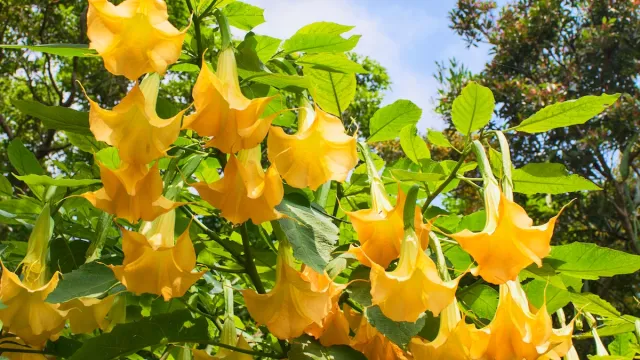23 Poisonous Plants Hiding in Your Backyard
Honeysuckle, rhubarb, and wisteria are among the most toxic plants out there, experts say.
When it comes to nature, the general rule of thumb is this: The poisonous stuff looks scary, and the harmless stuff looks beautiful (or, at the very least, unassuming). So it might be a surprise, then, to learn that plants and flowers—often beautiful, always unassuming—rank among the most dangerous things on the planet. And no, we're not just talking about the exotic blooms hiding in the Amazon—we're referring to the very plants and herbs that grow in your own backyard. Read on to find out what experts say are the poisonous plants that might be lurking just a few feet away.
READ THIS NEXT: 8 Easy Outdoor Plants That Don't Need Sunlight.
23 Poisonous Plants
1. Lily of the Valley
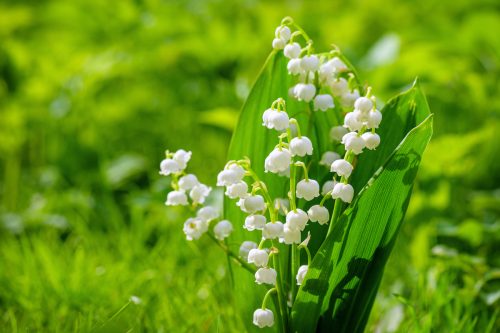
Of all the poisonous plants on this list, the dainty, sweet-smelling Lily of the Valley was cited most by experts.
As Amber Noyes, horticulturist and editor at Gardening Chores, explains, every part of this plant, down to the water in its vase, is poisonous. The flowers themselves, though, are the most dangerous part.
Lily of the Valley's toxicity comes from the cardiac glycosides and saponins present in the plants.
"The severity of symptoms, ranging from digestive disorders to cardiac arrest, depends on the quantity ingested and the individual's age," Noyes notes.
Lilies, in general, are also dangerous to keep around pets. "Extremely toxic to cats, they can cause acute kidney failure if ingested," says Ben Hilton, founder and editor at The Gardening Fix. "They're less harmful to dogs…but can still cause digestive upset."
2. Oleander
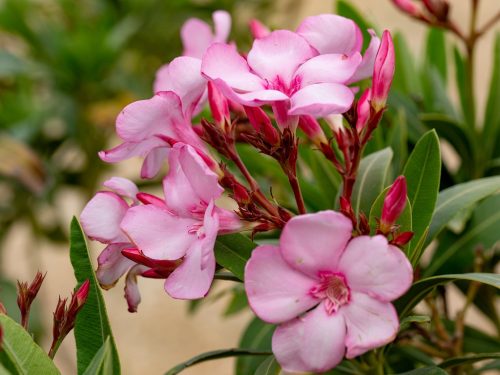
Known for its striking flowers in the summertime, the oleander plant also holds a deadly secret: Every part of it is highly toxic.
According to a 2010 study published in Heart Views, parts of the oleander plant contain cardiac glycosides, compounds that can cause acute cardiac toxicity and digestive issues. Those who ingest the plant can also suffer symptoms that range from an erratic pulse to a coma.
Julia Omelchenko, resident botany expert for the NatureID app, suggests wearing gloves if you are going to plant oleander, as it can irritate the skin.
3. Rhododendron
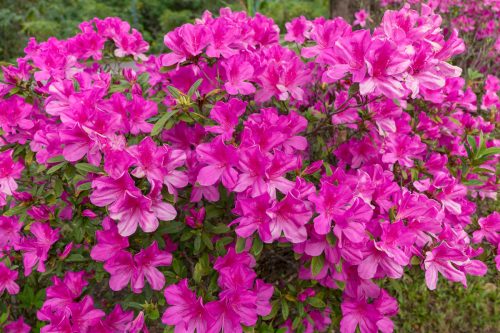
Rhododendron, a plant family that includes azaleas, is another beautiful and colorful bloom that's not as nice as it looks.
"All its parts contain a highly poisonous neurotoxin called andromedotoxin, also known as grayanotoxin," explains Omelchenko. "If ingested, it can cause vomiting, abdominal pain, cardiovascular problems, and even death."
She adds that rhododendron is also very toxic to pets and domestic animals, such as cats, dogs, goats, sheep, and cattle.
4. Honeysuckle
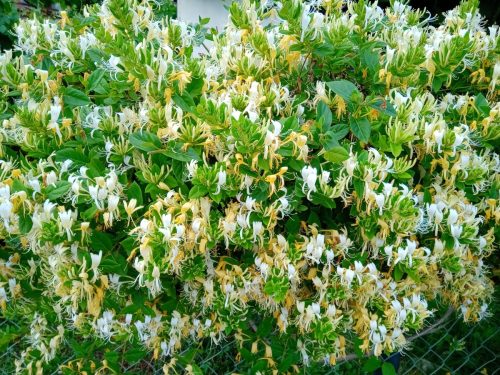
When the warm weather hits, honeysuckles might be one of the sweetest-smelling and most cheerful plants around—just don't go near their berries.
"The entire honeysuckle plant is toxic, but the berries pose the greatest threat, especially to young children," says Noyes. "For children under three years old, consumption of just two to three berries can result in severe poisoning. For adults, the critical number rises to 30 berries."
Symptoms of honeysuckle poisoning include vomiting, diarrhea, abdominal pain, sweating, dizziness, fever, convulsions, or rapid heart rate, she says.
5. Daffodil
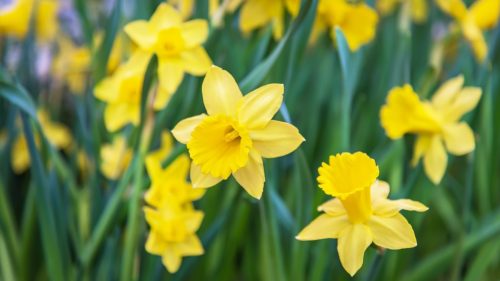
If you seek help quickly, ingesting daffodils won't kill you. However, according to the National Capital Poison Center (NCPC), ingestion can be fatal to small children and pets if left untreated.
And while all parts of a daffodil contain the toxic chemical lycorine, it's the oxalates—or toxic chemicals found in the plant's bulb—that do the most damage to your body.
According to Hilton, symptoms include vomiting, diarrhea, abdominal pain, and heart problems.
READ THIS NEXT: 18 Mistakes That Are Destroying Your Garden.
6. Rosary Pea

Native to tropical areas and often found in Florida, the rosary pea is considered one of the most invasive—and one of the most poisonous—plant species.
According to the Centers For Disease Control and Prevention (CDC), the plant's seeds contain the toxin abrin. And it turns out, there's enough abrin in just one seed to kill you if swallowed.
The University of Florida's Center for Aquatic and Invasive Plants notes that birds seem to be immune to the plant's toxicity and, therefore, "they readily disperse rosary pea seed."
They also explain that it's so named because "the seeds of this plant are so uniform in size and weight that they are used…to make jewelry, including rosaries."
7. Rhubarb
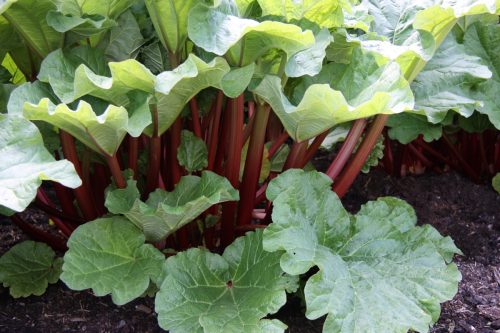
Sure, it makes a killer pie, but ingesting large amounts of rhubarb leaves can actually kill you.
"The leaves contain oxalic acid, which is toxic to humans and pets if eaten in large amounts," Hilton says. "It can cause burning of the mouth, throat, and digestive system, and can lead to kidney problems."
Thankfully, experts at the University of California, Santa Clara note that you'd have to eat some 12 pounds of rhubarb to really get sick.
8. Castor Bean Plant
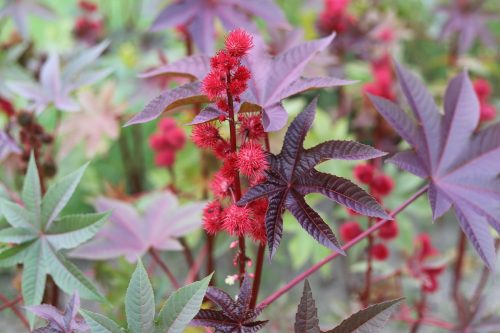
The castor bean plant is a large, fast-growing shrub. Its seeds (or beans) are used to make castor oil, which is a safe skincare ingredient and laxative, according to WebMD. However, the raw seeds are not safe at all.
Gene Caballero, co-founder of GreenPal, notes that all parts of the plant, but especially the seeds, contain the highly potent toxin ricin.
"Ricin can cause severe vomiting, diarrhea, dehydration, organ failure, or death if ingested by humans or animals," he says. "Even one seed can be fatal for a child or a pet."
Hilton adds that it's generally safe to touch but can cause skin irritation in some people.
9. Devil's Helmet
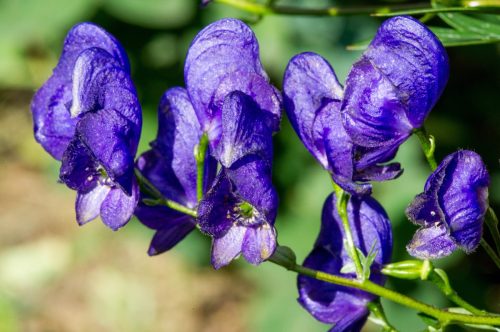
Also known as Aconite, wolf's bane, or blue rocket, devil's helmet produces gorgeous blue-violet flowers. However, in 2014, a gardener died after simply brushing up against a plant. And believe it or not, the plant's exterior isn't even its most poisonous part.
"Alarmingly, every part of the aconite plant is poisonous, with the roots being particularly potent," shares Noyes. "As little as three grams can cause death if ingested, and even contact can lead to severe intoxication. Therefore, it's essential to wear gloves when handling this plant."
This plant is ominously nicknamed "vegetable arsenic," adds Noyes. "In ancient times, it was used to poison hunting tools and drinking water."
10. Colchicum
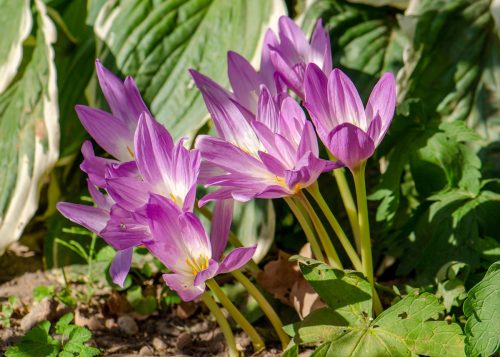
Colchicum, also known as Autumn crocus, meadow saffron, or naked ladies, is another plant that produces vibrant purple and pink flowers.
"However, its alternative name, 'dog killer,' hints at the darker side of this plant—all varieties of Colchicum are toxic, making it lethal to both humans and animals if ingested," says Noyes.
"Every part of Colchicum is poisonous, including leaves, flowers, seeds, and roots. The plant produces colchicine, a highly toxic alkaloid with mutagenic properties," she explains.
"If ingested, Colchicum can cause severe digestive disorders, including intense stomach pains, vomiting, and persistent diarrhea, which can lead to severe dehydration," Noyes adds. "This can result in a dangerous drop in blood pressure, potentially leading to cardio-respiratory arrest."
"Other serious complications, such as damage to the liver and blood cells, may follow," she says. "Death can occur up to 10 days after consuming the plant."
For more gardening and safety advice delivered straight to your inbox, sign up for our daily newsletter.
11. Deadly Nightshade
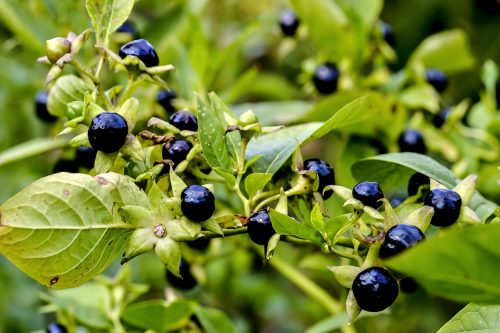
Unsurprisingly, the deadly nightshade plant is, well, deadly. It belongs to the Solanaceae family, which also includes tomatoes, eggplant, potatoes, peppers, and tobacco, according to WebMD.
All of these plants contain varying amounts of alkaloids, they explain, but the levels found in common vegetables are considered safe for consumption (you'd have to eat roughly 12 entire eggplants to feel ill).
But the nightshade plant (also known as Belladonna) has a high concentration of alkaloids in its stems, leaves, roots, and, especially, berries. Even rubbing up against it can irritate the skin, according to the Royal Horticultural Society.
Ingesting the berries "can cause vomiting, diarrhea, headache, confusion, and even paralysis or death if eaten in large amounts," says Caballero. It would take just two berries from this plant to kill a child and between 10 and 20 to kill an adult.
And as Omelchenko notes, even the leaves and shoots of tomato and eggplant plants are toxic to humans and animals.
12. Devil's Trumpet
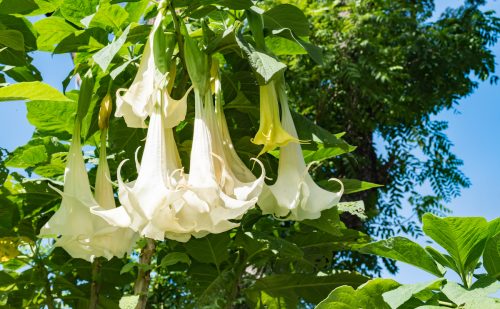
Devil's Trumpet, formally known as Datura and also referred to as jimsonweed or (ironically) Angel's Trumpet, is another member of the Solanaceae family. It's a tropical plant known for its beautiful trumpet-shaped flowers. And while it's aesthetically pleasing, the last thing you'd ever want to do is find out what it tastes like.
"All parts of the plant are poisonous, and ingestion can lead to hallucinations, confusion, rapid heart rate, and even coma or death," Benita Middleton, head gardener at Benita's Garden Services, tells Best Life.
As one 2008 case report published in Paediatrics & Child Health details, in the summer of 2006, four adolescent patients were hospitalized after ingesting Datura.
"All four patients had a decreased level of consciousness measured by the Glasgow Coma Scale, visual hallucinations, dilated pupils and agitation," the report says. "The changes in mental status are characteristic of delirium." With proper medical attention, they all fully recovered.
13. Yew
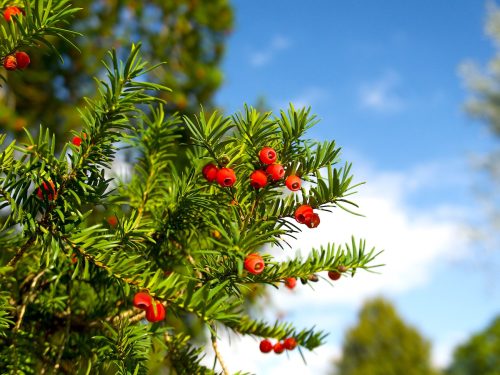
In ancient cultures, yew is also called the "tree of death," as it was once used as an offering to the gods of death. And there's a reason why: According to Cornell University's Department of Animal Science, the yew plant, found in all corners of the world, is dangerously toxic.
No matter how you consume the plant, its toxins have the potential to cause cardiac arrhythmia and stop your heart entirely. Animals that eat the plant are often found deceased next to it just 24 to 48 hours after consumption.
14. Sago Palm
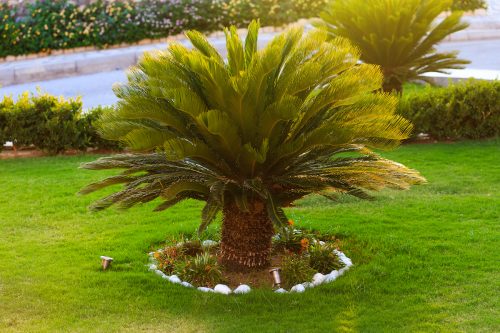
Strangely, the sago palm is not a member of the palm family; it's part of the evergreen Cycas revoluta family. And though it's a lovely and easy-to-grow houseplant or outdoor plant, it's quite dangerous.
"All parts of this plant are toxic to pets, especially dogs, due to a toxin called cycasin," says Hilton. "If ingested, it can cause vomiting, liver failure, and death. It can also be harmful to humans if ingested, but this is less common."
15. Foxglove
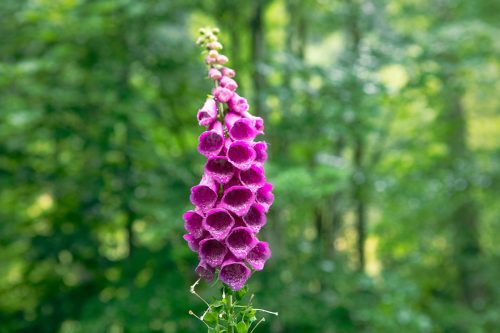
According to Hilton, the foxglove plant produces digitalis glycosides, which, as the Cleveland Clinic explains, "are [included in] medications people take for heart failure, atrial fibrillation, and atrial flutter."
By ingesting foxglove, you're essentially "taking an unregulated dose of heart medicine," which can, ironically, cause heart failure, adds the NCPC.
"The leaves, seeds, and flowers of this plant are all dangerous if eaten by humans or pets," Hilton says. As such, you should keep this plant far, far away from children and animals.
16. White Snakeroot
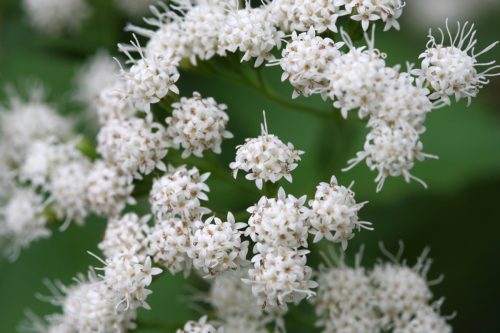
Ageratina altissima, or white snakeroot, is a poisonous herb found in North America that contains a toxic alcohol called tremetol. But just how poisonous is this plant?
Well, back when explorers were first settling Indiana and Ohio in the early 19th century, it's estimated that up to half of their deaths—including that of Abraham Lincoln's mother, Nancy Hanks Lincoln—were caused by indirectly ingesting white snakeroot.
Cattle and other livestock in the area would eat the seemingly benign herb and pass the poisonous tremetol to humans via their milk. The illness was known as fatal milk sickness.
Though it's rare today, "Humans who have ingested the toxins by drinking the milk of cows that have eaten the plant display weakness, muscle spasms, vomiting, constipation, thirst, delirium, and coma," according to the Missouri Department of Conservation.
17. American Pokeweed
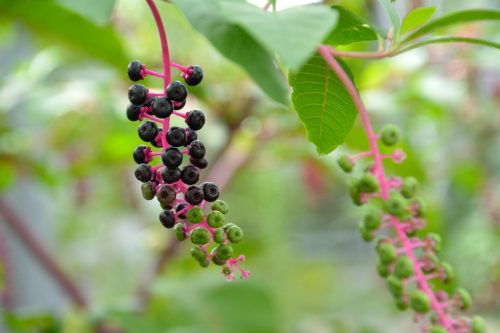
American pokeweed is found in almost every area in the U.S., save for a few states in the northwestern region. And while the plant does produce a purple-black berry known as a pokeberry, the last thing you'd ever want to do is eat one.
According to the NCPC, consuming these can cause everything from nausea and vomiting to low blood pressure. If you have children, make sure to monitor them when they're playing in your yard, as the NCPC notes that youngsters often mistake these berries for grapes.
18. Wisteria
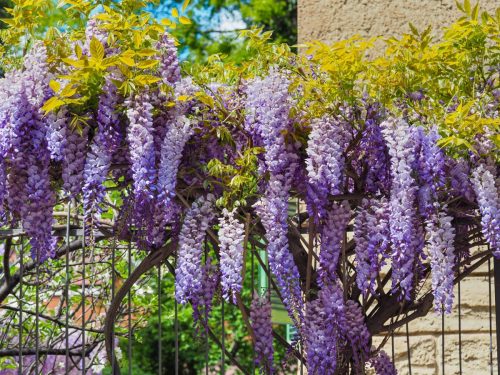
When it comes to dangerous plants in your backyard, wisteria is one of the worst ones there is. According to one case study from the Santa Clara Valley Medical Center, the wisteria plant can cause headaches, gastroenteritis, hematemesis, dizziness, confusion, diaphoresis, and, frighteningly, syncopal episodes (or temporary drops in blood flow to the brain that result in a loss of consciousness and control of the muscles).
These symptoms typically last for five to seven days after eating more than a few berries from the plant—if they don't kill you, that is.
READ THIS NEXT: 7 All-Natural Ways to Keep Your Garden Pest-Free, According to Experts.
19. Water Hemlock
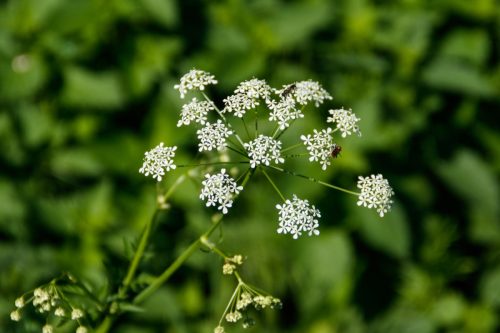
If you know anything about water hemlock, then it's likely that you're familiar with the plant's claim to fame: Killing Socrates.
According to the United States Department of Agriculture (USDA), this plant contains the toxin cicutoxin, which, when ingested, acts directly on the central nervous system. In the most extreme cases, that could result in grand mal seizures and death.
"[Cicutoxin] is found principally in the tubers, but is also present in the leaves and stems during early growth," explains the USDA. "Leaves and stems lose most of their toxicity as they mature; however, green seed heads are poisonous."
20. Hydrangea
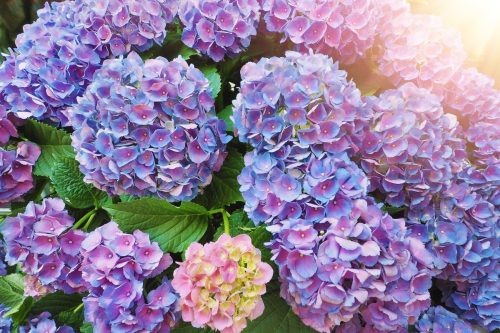
As far as the poisonous nature of the popular hydrangea plant is concerned, only the flower buds are truly harmful when ingested, according to the Canadian Biodiversity Information Facility.
If consumed, humans can experience an upset stomach, skin irritation, and, in more serious cases, convulsions and coma.
21. Tulip
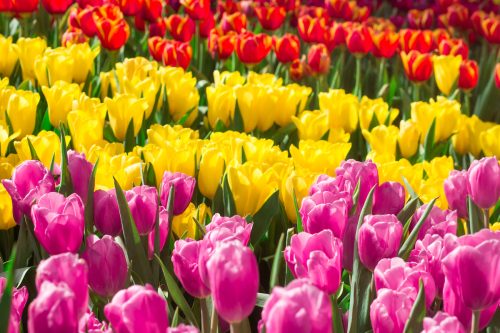
Tulips might make your garden shine, but they also have the potential to poison your pet.
According to the ASPCA, this plant is toxic to dogs, cats, and horses in its bulb especially, and symptoms of ingestion range from vomiting and diarrhea to hypersalivation and depression.
The NCPC also explains a condition known as "tulip fingers," an irritating rash that can occur after handling tulips. "A chemical called tuliposide is responsible for this reaction. It is found mostly in the outer layers of tulip bulbs," they explain. "After repeated exposures, the skin's reactions get worse and a painful rash can occur. This rash can affect both the fingertips as well as the area around the fingernails."
22. English Ivy
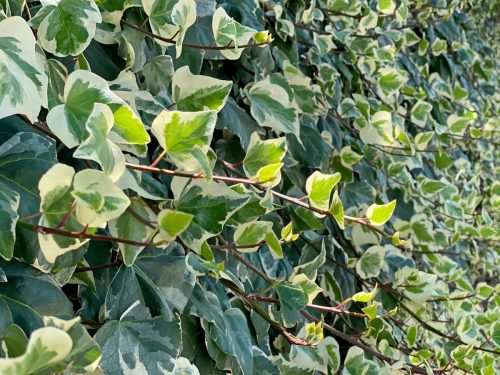
You may covet that old house with English ivy trailing up its facade, but your ivy-less abode may well be safer.
"This common vine is toxic to pets and humans if ingested due to saponins," says Hilton. "It can cause vomiting, abdominal pain, hypersalivation, and diarrhea. The plant can also cause skin irritation if touched."
23. Poison Ivy
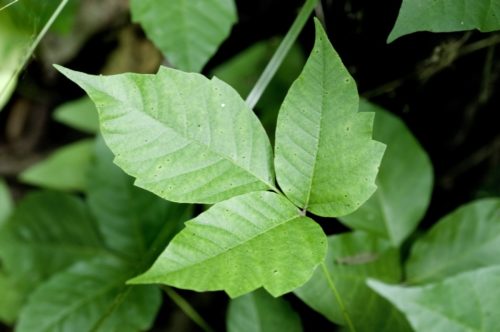
We probably didn't have to tell you that poison ivy is poisonous.
Along with poison oak and poison sumac, it causes "allergic contact dermatitis, a skin reaction that results from touching the plant's oil called urushiol," explains Caballero. "The symptoms include itching, redness, swelling, and blisters that may last for weeks."
"These plants can be found in various regions of North America and have different leaf shapes and colors depending on the season," he adds.
And as the Mayo Clinic warns, "Even the smoke from burning poison ivy, poison oak and poison sumac can irritate or harm your nasal passages or lungs." This can lead to difficulty breathing.
- Source: https://www.ncbi.nlm.nih.gov/pmc/articles/PMC3089829/
- Source: https://emergency.cdc.gov/agent/abrin/basics/facts.asp
- Source: https://plants.ifas.ufl.edu/plant-directory/abrus-precatorius/
- Source: https://www.ncbi.nlm.nih.gov/pmc/articles/PMC2529415/
- Source: https://my.clevelandclinic.org/health/treatments/24512-cardiac-glycosides
- Source: https://www.ncbi.nlm.nih.gov/pubmed/8433406
